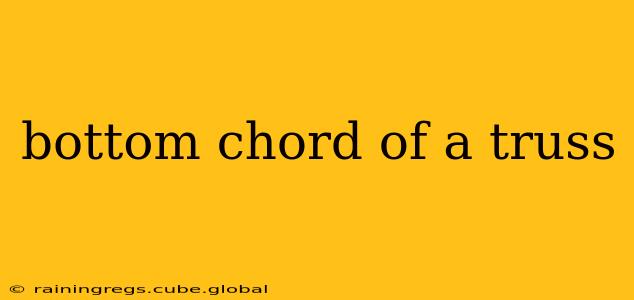Trusses are essential structural elements found in bridges, roofs, and many other constructions. They're composed of interconnected members forming a rigid framework, and understanding their components is crucial for structural integrity. This guide focuses on the bottom chord of a truss, exploring its function, design considerations, and common applications.
What is the Bottom Chord of a Truss?
The bottom chord of a truss is the horizontal member forming the lower boundary of the triangular or polygonal structure. It's a key component responsible for carrying significant tensile loads, meaning it's subjected to pulling forces. Think of it as the foundation upon which the entire truss rests and distributes its load. Unlike the top chord, which primarily experiences compression (pushing forces), the bottom chord is designed to resist stretching.
What is the function of the bottom chord in a truss?
The primary function of the bottom chord is to resist tensile forces. These forces are generated by the loads acting on the truss, such as the weight of a roof or the traffic on a bridge. The bottom chord transfers these tensile forces to the supports at the ends of the truss. Essentially, it acts as a continuous tension member that keeps the truss from collapsing.
What are the different types of bottom chords?
Bottom chords can vary in their design and material depending on the specific application and load requirements. Common types include:
- Single member chords: A single, continuous member spans the entire length of the truss. This is common in smaller trusses.
- Multiple member chords: Several smaller members are connected together to form the bottom chord. This is typical in larger trusses to manage stress distribution more effectively. These smaller members are often connected with gusset plates.
- Steel bottom chords: Steel is a prevalent material due to its high tensile strength and durability.
- Wood bottom chords: Wood can also be used in certain applications, particularly in smaller structures where the loads are less substantial. Proper treatment is needed for durability.
How is the bottom chord designed?
The design of the bottom chord is crucial for ensuring the safety and stability of the entire truss. Engineers consider several factors, including:
- Load calculations: Accurate determination of the tensile forces acting on the bottom chord is fundamental.
- Material selection: The material's tensile strength and other properties are crucial in determining its size and cross-sectional area.
- Connection design: The joints connecting the bottom chord to other members of the truss must be strong and reliable to prevent failure. This often involves the use of high-strength bolts or welds.
- Deflection considerations: The bottom chord's stiffness and ability to resist deflection under load are important aspects of the design.
What are common applications of trusses with bottom chords?
Trusses, and thus their bottom chords, find diverse applications:
- Roof structures: Trusses form the primary support for roofs in buildings of various sizes and types.
- Bridges: Many bridges utilize truss structures to support the deck and traffic loads.
- Industrial buildings: Trusses provide strong and efficient support in large-span industrial buildings.
- Footbridges: Pedestrian bridges often employ lightweight truss designs.
How does the bottom chord interact with other truss members?
The bottom chord interacts with other truss members, primarily the web members and top chord, to form the overall load-carrying system. Web members (the diagonal and vertical members) transfer loads from the top chord and applied loads to the bottom chord. The interaction between these members ensures the efficient distribution of loads throughout the truss structure.
What materials are typically used for bottom chords?
The most common materials for bottom chords are steel and wood, although other materials like aluminum alloys might be used in specific applications. The selection depends on factors like cost, strength requirements, weight limitations, and environmental considerations. Steel is favored for its high tensile strength and durability in high-load scenarios.
How are bottom chords connected to other members of the truss?
Connections between the bottom chord and other truss members are critical for load transfer and overall stability. Common connection methods include bolted connections, welded connections, and pinned connections. The specific method chosen depends on the materials used, the magnitude of the forces, and the design requirements. Gusset plates are frequently utilized to enhance the strength and efficiency of these connections.
This comprehensive guide provides a solid understanding of the bottom chord of a truss, its function, design considerations, and various applications. Remember that proper engineering design and material selection are critical for ensuring the safety and longevity of any truss structure.
